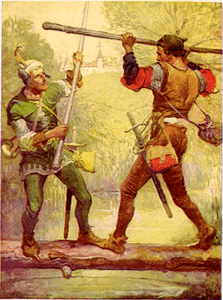Welcome to Facts Vibes! Let’s delve into the legendary world of Robin Hood. Uncover intriguing facts about the infamous outlaw, his band of Merry Men, and the timeless tales of stealing from the rich to give to the poor. Join us on a captivating journey through history and folklore.
The Fascinating History of Robin Hood: Myths and Facts
The fascinating history of Robin Hood: Myths and Facts
Robin Hood is a legendary figure who has captured the imagination of people around the world for centuries. His story has been the subject of numerous ballads, books, movies, and television shows, and his legacy continues to endure.
There are many myths surrounding Robin Hood, but separating fact from fiction can be a challenging task. One of the most enduring myths is that Robin Hood was a nobleman who was forced to become an outlaw due to unjust laws imposed by the ruling class. However, historical evidence suggests that Robin Hood may have actually been a commoner who fought against the oppression of the powerful.
Another popular myth is that Robin Hood robbed from the rich to give to the poor. While this idea has been romanticized in popular culture, it is difficult to determine the extent to which it reflects historical reality. Some historians argue that the legend of Robin Hood may have been inspired by various real-life outlaws who operated in the forests of medieval England.
Despite the uncertainty surrounding the details of Robin Hood’s life, his status as a symbol of resistance against injustice and tyranny remains powerful. The image of a skilled archer and swordsman who fought for the rights of the downtrodden has made Robin Hood a beloved figure in popular culture.
In conclusion, the story of Robin Hood is a complex tapestry of myths and facts that continues to captivate audiences to this day. Whether he was a noble hero or a common outlaw, the legend of Robin Hood endures as a timeless tale of justice and bravery.
Most popular facts
Robin Hood is a legendary figure in English folklore, known for robbing from the rich and giving to the poor.
Robin Hood is a legendary figure in English folklore, known for robbing from the rich and giving to the poor.
The first literary reference to Robin Hood appears in a 1377 manuscript “Piers Plowman.”
The first literary reference to Robin Hood appears in a 1377 manuscript “Piers Plowman.”
Sherwood Forest in Nottinghamshire, England, is traditionally associated with Robin Hood and his band of Merry Men.
Sherwood Forest in Nottinghamshire, England is traditionally associated with Robin Hood and his band of Merry Men.
His group of followers, known as the Merry Men, included famous figures such as Little John and Friar Tuck.
His group of followers, known as the Merry Men, included famous figures such as Little John and Friar Tuck.
Many different locations throughout England claim to be the birthplace or home of Robin Hood.
Many different locations throughout England claim to be the birthplace or home of Robin Hood.
The earliest known ballads about Robin Hood date back to the late medieval period.
The earliest known ballads about Robin Hood date back to the late medieval period.
Robin Hood’s arch-nemesis is the Sheriff of Nottingham, who is often depicted as his adversary in various tales and adaptations.
Yes, Robin Hood’s arch-nemesis is the Sheriff of Nottingham, who is often depicted as his adversary in various tales and adaptations.
Maid Marian is a recurring character in Robin Hood stories, often depicted as his love interest or ally.
Maid Marian is a recurring character in Robin Hood stories, often depicted as his love interest or ally.
The stories of Robin Hood have been adapted into numerous plays, films, and television shows over the years.
The stories of Robin Hood have been adapted into numerous plays, films, and television shows over the years.
The concept of redistributing wealth from the rich to the poor has made Robin Hood a symbol of social justice.
Robin Hood has become a symbol of social justice due to the concept of redistributing wealth from the rich to the poor.
Historians debate whether Robin Hood was a real historical figure or a purely fictional character.
Historians debate whether Robin Hood was a real historical figure or a purely fictional character.
Robin Hood is often portrayed as a skilled archer, using his bow and arrow to outsmart his enemies.
Robin Hood is often portrayed as a skilled archer, using his bow and arrow to outsmart his enemies.
The legend of Robin Hood has become a popular subject in English literature and has inspired many writers and poets.
The legend of Robin Hood has become a popular subject in English literature and has inspired many writers and poets.
Various theories exist about the origin of the name “Robin Hood,” with some associating it with medieval outlaw traditions.
The origin of the name “Robin Hood” is linked to medieval outlaw traditions and has given rise to various theories.
The enduring popularity of the Robin Hood legend has led to the creation of tourist attractions and festivals in the areas linked to his story.
The enduring popularity of the Robin Hood legend has led to the creation of tourist attractions and festivals in the areas linked to his story.
In conclusion, the Robin Hood facts presented shed light on the enduring legacy of this legendary figure within the context of justice and societal inequality. His portrayal as a hero who championed the plight of the oppressed continues to inspire and resonate with audiences today.
